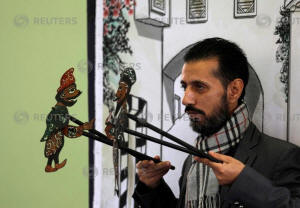|
Traditional shadow theater was historically a staple of Damascus
cafe life, as story tellers used dyed animal-skin puppets to
entertain their audience with tall tales, satire, songs and
verse.
Last week the U.N.'s cultural agency UNESCO added Syrian shadow
puppetry to its list of intangible heritage in urgent need of
saving, noting its long decline in the face of modern forms of
entertainment and the displacement caused by war.
"Until three or five days ago, it was an art that didn't provide
bread. Now we are thinking of buying bread and eating bread... I
hope for the better," said Shadi al-Hallaq, the last puppeteer.
When he took it up in his late teens in 1993, traditional shadow
puppetry was already all but forgotten and his family worried he
could never make it his living.
He revived the art from old stories and history books, and made
the puppets himself. They are crafted from camel, cow or donkey
hide and each character represents a particular social trait.
At a recent performance, Hallaq used a translucent screen,
painted to resemble an alleyway in the Old City of Damascus, to
tell a story about unscrupulous traders using the traditional
two main characters - naive Karakoz and the wise, wily Aywaz.
These two puppets, controlled with sticks and pressed against
the back of the screen with the light behind them, so that their
shadows are projected upon it, are the only ones he has left.
Early in the war, Hallaq lost his mobile theater set and 23
other hand-made characters in eastern Ghouta, just outside
Damascus, as the conflict flared.
He fled the fighting, crossing the border into Lebanon, where he
worked for two years as a laborer. While there he sometimes
performed for Syrian school children and it was during such a
show that UNESCO officials first noticed him.
Now back in Damascus, he will start teaching a group of
prospective puppeteers in about six months to ensure the art
survives, said Rasha Barhoum, a Syrian cultural official.
"I can imagine how happy people will be to see this art survive
and not disappear because it is part of our heritage and our
culture," Hallaq said.
(Reporting By Kinda Makieh, writing by Angus McDowall; editing
by Raissa Kasolowsky)
[© 2018 Thomson Reuters. All rights
reserved.] Copyright 2018 Reuters. All rights reserved. This material may not be published,
broadcast, rewritten or redistributed.
Thompson Reuters is solely responsible for this content.

|
|







